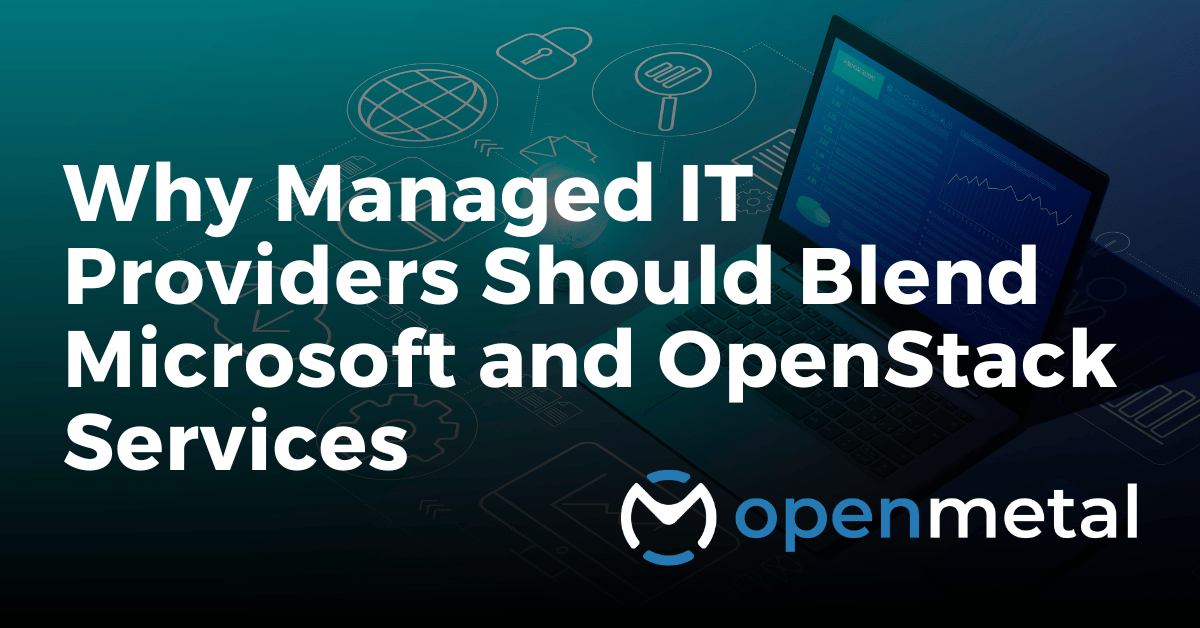As a managed IT service provider, you’re always looking for ways to provide the best possible service to your customers. And, in competitive times like this, to distinguish yourself from the hundreds of other IT providers who all seem to do the same thing. Offerings like remote monitoring and management, software updates, hardware refreshes, and helpdesk support are table stakes for any MSP nowadays.
How can you provide increasingly great service, grow profits, AND stand out from the crowd? For starters, by not offering the exact same products and services as everyone else!
Challenging the Norm of Microsoft Everything
For most MSPs, defaulting to Microsoft services is the norm. They’ve courted managed IT providers for many years and developed a (formerly) strong partner program. But Microsoft has been steadily restricting this program and abandoning many smaller partners – anyone who they essentially decided wasn’t worth the benefits they provide. They’ve also been known to circumvent their partners and resellers by poaching customers for themselves.
These incidents plus growing dissatisfaction with service levels has caused much uproar in MSP communities. But the consensus seemed to be: what other choice do we have? MSPs and their clients were already so ingrained in the Microsoft ecosystem that any outrage had no real resolution.
A Better Way
As frustration around the mega providers like Microsoft and Amazon has increased in recent years, we frequently run into IT providers looking for better solutions. Closed-source services, while convenient, often don’t provide the control and ROI that MSPs crave. Prices rise every year, more restrictions are imposed, customer service takes a nose-dive, service quality degrades, products disappear…sound familiar? As late-night infomercials love to tell us, “there’s got to be a better way!”
And there is! Here’s a radical approach that no one seems to be taking advantage of – combining Microsoft and OpenStack offerings.
Blending Microsoft and OpenStack for Managed IT Service Providers
As you probably know, Microsoft is a massive technology company that offers a wide range of products and services, including operating systems, productivity software, and cloud services. OpenStack, on the other hand, is an open source cloud computing platform that allows users to create and manage their own cloud infrastructure.
OpenStack has a reputation for being complicated and resource-intensive to deploy. While it’s used by many large companies like Best Buy and Adobe, smaller firms have been discouraged from even considering it. Who would want to spend hundreds of working hours and dollars wading through extensive documentation learning how to use a community-supported product when there are simple solutions like Azure?
That’s why OpenMetal was founded in the first place. We’re huge proponents and beneficiaries of open source software. OpenStack is an incredible tool that offers the customization and control that companies need. We wanted to completely simplify its use and make it more accessible to firms of all sizes and skill sets. With OpenStack on OpenMetal, you can spin up a new OpenStack cloud in just 45 seconds. When OpenStack is that simple, it opens up a new world of possibilities for IT service providers, cloud and hosting businesses, SaaS orgs, and any other technology company searching for better options.
Now, this isn’t to encourage giving up Microsoft products entirely. Their Office suite continues to dominate the market, Azure offers expansive enterprise-level options and services, and obviously Windows isn’t going anywhere for most companies. You can even integrate any Microsoft services you love with OpenStack, like Active Directory. But when it comes to cloud infrastructure, most companies can save a bundle and serve their customers more effectively by leaning into open source platforms like OpenStack.
More Flexibility
So, what are some solid reasons for offering a mix of Microsoft and OpenStack? The first reason is simple: flexibility. By combining Microsoft and OpenStack, you can offer your customers a wide range of options for their cloud infrastructure.
Microsoft Azure is a powerful cloud platform that offers a wide range of pre-packaged services, including virtual machines, storage, and networking. OpenStack, on the other hand, allows users to create and manage their own completely custom cloud infrastructure, allowing more control over their environment.
By combining these two offerings, you can offer your customers the best of both worlds. They can take advantage of the power and robustness of Microsoft Azure while also having the ability to create and manage their own cloud infrastructure using OpenStack. Or, for you as the service provider, to create completely customized cloud infrastructure for clients with unique needs that may not fit into the traditional proprietary cloud box. Or even perhaps for your MSP to maintain its own internal testing infrastructure without paying for yet another Azure instance. The possibilities are nearly endless.
Cost Savings and Better ROI
Another benefit of combining Microsoft and OpenStack is cost savings. Microsoft Azure can be expensive, especially for smaller businesses. By using OpenStack to create and manage their own cloud infrastructure, your customers can save money on their cloud computing costs. This can be a huge selling point for your services, as cost savings are always a top priority for businesses.
Using OpenStack also doesn’t require purchasing licensing – typically a huge cost center for managed IT service providers.
View a customer success story about how a SaaS provider achieved 50% savings by moving their DevOps workloads to OpenMetal.
Standing Out From the Crowd of MSPs
Aside from flexibility and cost savings, differentiating yourself is essential for MSP survival. Anyone can purchase an RMM tool, set up automated patching, and say they provide managed services. If, likewise, you’re simply riding the bandwagon and offering the same products as every other guy in town, prospects will just go with whichever provider is cheapest.
But, if you’re the only MSP providing unique options like OpenStack, you’ll instantly stand out from the crowd. Modern customers want options outside of huge conglomerates. Open source solutions are a way to provide greater cost savings, new business possibilities, and a painless exit from the monoliths. Imagine your very own managed private cloud solution!
Improved Cybersecurity and Control
As security concerns grow, taking advantage of alternative cloud solutions like OpenStack makes sense, too. MSPs have a massive target on their backs – if an attacker can make it into their systems, they have access to dozens or hundreds of other businesses and their sensitive information. You’re incredibly valuable to cybercriminals.
Being able to lock down and impose your own level of controls on cloud infrastructure is important. While Microsoft obviously spends an eye-watering amount on security, they aren’t infallible. The more control you can gain over the platforms and software you provide customers, the less chance there is for security incidents.
Wrapping Up
Combining Microsoft and OpenStack offerings is a powerful way to provide flexible, cost-effective, and secure cloud computing solutions to your customers. By offering the best of both worlds, you can help your customers meet their specific business needs while also saving them (and yourself) money. So, if you’re a managed IT service provider, consider adding this powerful combination to your list of offerings. Your customers and your finances will thank you for it!
More on the OpenMetal Blog…

OpenStack Tutorial for Beginners
In this blog:
- Definition of OpenStack
- Agenda of OpenStack YouTube Tutorial
- How to Use Request a Cloud Trial to Use Along with the Tutorial
- Watch the Video Tutorial

Why is On-Demand OpenStack Important for SMBs?
In this blog:
- Why Build a Low-Cost, On-Demand OpenStack Private Cloud?
- Why is it Important for SMBs to be a part of the OpenStack, Open Source Community?
- Can this help other organizations like Universities or Governments?
- Why is OpenStack not in more common use by SMBs or similar organizations?
- OpenMetal’s Open Source Commitment

Matching Public Cloud Offerings with OpenStack
In this blog:
- Database as a Service (DBaaS)
- Functions as a Service (FaaS)
- Object Storage
- Do Your Due Diligence
Test Drive
For eligible organizations, individuals, and Open Source Partners, Private Cloud Cores are free to trial. Apply today to qualify.
Subscribe
Join our community! Subscribe to our newsletter to get the latest company news, product releases, updates from partners, and more.



































